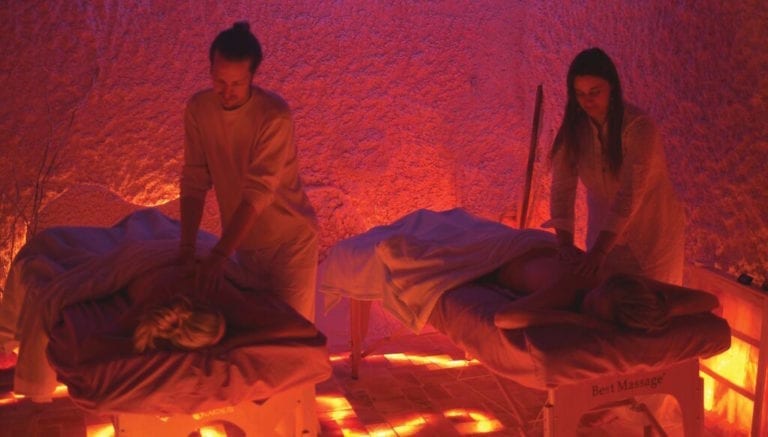Halotherapy believers extol benefits of salt caves
By Rebecca Carr
Photographs by Josh Norris
Inside an unassuming Asheville, N.C., storefront is a room coated in five tons of pink Himalayan salt shipped from Pakistan. Salt tiles cut a path through a floor of pebble-sized salt. A wavy cloth covers the ceiling, creating a cool, serene atmosphere.
The Salt Spa of Asheville is part of a growing new health and wellness trend — submerge your senses in a cave-like room where a special device called a halogenerator crushes sodium chloride into a dry aerosol and disperses it into a room, creating a microclimate similar to a salt cave. Breathing the pristine salt air is believed to strengthen your immunity, improve chronic respiratory conditions and make your skin glow.
That’s a tall order, to be sure, but something must be working. The total number of salt caves across the country has jumped from about a dozen five years ago to more than 300 today, according to the Salt Therapy Association, a Florida-based trade group.
Skeptics argue there is no scientific evidence that salt therapy works to heal children with cystic fibrosis or adults with chronic lung disease, but don’t tell that to devoted fans of salt therapy like William Hilson. Hilson, 68, came to the Himalayan Salt Cave a few months ago with swollen lymph nodes, stemming from a battle with pulmonary fibrosis, a deadly lung disease. After three sessions, he said, the swelling dissipated, and his condition has stabilized with regular visits.
“I could not take a breath without coughing when I came here,” Hilson said. “Now, I can breathe again, and I feel so much better.”
Ines Clark, who opened The Salt Spa of Asheville in 2011, is quick to clarify that halotherapy does not cure diseases. “But it definitely slows down diseases dramatically.”
I decided to try out the salt cave for myself.

Glowing lights and soft music set the tone for relaxation at The Salt Spa of Asheville in North Carolina.
I removed my shoes in the spa’s “relaxation area” and then was taken to a recliner inside the salt cave and tucked into a blanket by Clark. I closed my eyes, unsure of what to expect. For the next 45 minutes, I breathed pure sodium chloride from the cave’s halogenerator.
My nose immediately started to tingle as I breathed in the pure air of the cave. I fell into a loosely meditative state and slowly started to unwind. My back pain, sore from lugging suitcases on a recent summer trip, disappeared — along with a lengthy to-do list. The invisible negative ions, which increase oxygen to the brain, must be working, I told myself. The next thing I knew, I was floating to dreamy music in a hypnotic state.
When a gong signaled the end of the session, I felt invigorated as if I had just finished an intense yoga session despite having done little more than breathe.
The next stop was the relaxation room, where I sipped ginger tea with my feet perched on a salt orb illuminated and heated by an incandescent light bulb. The orb releases negative ions and warms feet.
There are tangible and intangible benefits to salt therapy. “You can’t really tell people what to expect because each experience is unique and personal,” Clark said.
“This is a powerful therapy, not just for the physical and respiratory systems, but for the spiritual system — the body, mind, and soul,” Clark said. “This is a way to rest and recharge yourself.”

Innes Clark, owner
Clark was trained as a physical therapist in her native Germany before moving to the United States in 2002. After hearing about the holistic medicinal benefits of halotherapy in Eastern Europe, she became interested in bringing the concept to the United States.
The Salt Spa of Asheville, the first of its kind to open in North Carolina, attempts to come as close to a real salt cave as possible.
It is challenging to create the microclimate of a natural salt mine. One can’t simply throw Himalayan salt from the grocery store on the wall and hope for the best. Clark and her husband built a grid on the walls of their spa and spent four weeks throwing salt on the walls with their then-7-year-old son to build up uneven, but carefully planned, walls that resemble the inside of a cave.
“Because of how these micron-size dry salt particles are produced, halotherapy has a much more profound therapeutic effect than salt water mist and is also safer. Halotherapy is a brilliant combination of healing and relaxation and is a safe, drug-free, natural and effective way to find relief from respiratory ailments like allergies, asthma, bronchitis, COPD, cystic fibrosis and more, including skin conditions,” Clark said. “Our purpose is to help people to feel at their best, and we always want to integrate other natural therapies into our spa.”
Sessions at the salt cave cost $35. The spa also offers sessions in a “far infrared heated salt bed,” a warm salt bed that heats and cleanses the body at $30 for 30 minutes. Yoga and gong meditation and crystal bowl meditation are also available.
The origins of halotherapy
Halotherapy dates back to the 11th century in Eastern Europe and Asia. In the 1840s, Dr. Feliks Boczkowski, a Polish doctor, published a book on the medicinal effects of salt mine chambers after studying the impact of underground mining. He found that coal miners were plagued by respiratory issues, but salt miners had clear lungs. The idea of a salt clinic was born. A few years later, the first known salt clinic was started in Poland, but it remained largely an Eastern European remedy until the 1980s.
That’s when Russian pulmonologist Dr. Alina Chervinskaya studied the air in several natural salt mines with the same therapeutic concentration of dry salt particles (1 to 5 microns) as well as an abundance of negative air ions in salt mines. Her research found that inhaling unpolluted salt air relaxed patients and improved their respiratory health. Chervinskaya’s work led to the development of halotherapy (halos is Greek for salt) and a halogenerator, making it possible to transport the medicinal value of salt mines all over the world.

Some salt cave businesses add massages to their offerings.
Salt cave growth
Salt caves (and rooms) are popping up all over the country in well-heeled spots like four-star hotels and upper-end spas. The Saks Fifth Avenue in Manhattan is offering a pop-up “wellness center” where shoppers can breathe pristine salt air in a salt booth until the end of October.
The biggest area of growth in the halotherapy industry is in stand-alone salt facilities as well as in med spas, day spas, country clubs and high-end resorts, according to Leo M. Tonkin, who founded the Salt Therapy Association and also runs Salt Chamber, a dry salt therapy equipment and décor company based in Boca Raton, Florida.
“The benefits of salt therapy (halotherapy) are evidence-based and well-documented in other parts of the world,” Tonkin said. “It is really starting to catch on in the spa and wellness industry as more people realize that it is not just about looking good, but feeling good.”
The business model for salt therapy has all of the elements of success—low labor and operational costs after the initial startup cost of creating a salt room or cave. The most important component is a halogenerator, Tonkin said.
“You can have a nice Himalayan salt wall and a waterfall with Tibetan music playing in the back or a room with Himalayan salt lamps, but that is not the real thing. You need to have a halogenerator so that you can breathe the ground up micronize-size particles of sodium chloride. If you do not have a halogenerator, you do not have halotherapy. So there is a lot of misconception in the industry about what is a real salt cave and what is not,” Tonkin said. The Salt Therapy Association plans to start accrediting salt rooms and caves to ensure that consumers are not duped into going somewhere that just has salt on the wall.
Back at The Salt Spa in Asheville, two women arrive ready to relax after dropping their daughters at a nearby sleep-away camp.
As they walked into the salt cave, one joked to the other, “This is definitely worth its salt.”

Want to get the salt cave experience at home? ELYSIAN found a way. Read here.

